Streets for People / With the Duval Street Revitalization Plan Way Behind Schedule, Here’s 3 Quick Wins for Pedestrianizing Duval Street Now
While last season doesn’t exactly seem to have ended, we have another season rolling around soon. Christmas is in 5 months, and the madness begins anew. Since the Duval Street Revitalization Plan has been delayed, let’s do some quick and relatively easy things now to get our Duval Street and Historic Downtown more pedestrian friendly by then. The recent Key West Community Survey of 3,700 residents showed “2/3’s of us are in favor of closing Duval Street for pedestrian traffic on evenings and/or weekends” and that “revitalization of Duval Street” is one of our top rated capital projects. We need to commit some money and staff time this summer during the budget process, get projects done in the fall and be ready for another season with some fresh pedestrian-friendly ventures.
The Duval Street Revitalization Plan Has Fallen into a Bureaucratic Black Hole
Mayor Johnston ran on a platform of revitalizing Duval Street in 2018. She came through by initiating the Mall on Duval pilot project in 2019 and that begat the release of a Duval Street Revitalization Plan RFQ on November 21, 2019 (RFQ). After an arduous and long process an amazing consultant team was selected at the August 19, 2020 City Commission meeting, a contract signed in November 2020 and a phase one budget and scope was in the works last winter. All was set for public meetings and a project start this past spring. And then the wheels came off.
One of project leads had quit the main firm. At the same time a local paper printed an “artist’s rendering” included in the consultant’s original submission depicting Duval Street as well, not very Duval Street like. There was such a hue and cry over the rendering and apoplexy over the loss of one person from the consultant team, that apparently city staff wanted to cut and run and change firms entirely. As we discussed in a previous article (The Wee Donkey, Whataboutism, Bathwater and Duval Street’s Future; February 19, 2020) it was an early rendering and meant nothing. And the two firms that partnered together to win the contract had such stellar reputations, that the loss of the project lead could have been overcome. But someone inside City Hall decided that they wanted a new firm. And rather than simply go to the second ranked firm, which was also excellent and lost the contract by just a few points, decided they needed to rewrite and put out an entirely brand new RFQ. So, twenty months after the first RFQ had gone out we’re still waiting for the next RFQ. As of this publication it still hasn’t been released. Staff doesn’t seem to be helping the Mayor out on this one, do they?
Once released, if the new RFQ process takes a year, like the first one did, we won’t have a consultant on board till the fall of 2022. If we’re lucky. And then the Study could take one or more years to complete, and we’ll be into 2023 or later. We’re mighty disappointed in City staff botching the Mayor’s signature wish for a Duval Revitalization Plan. So THAT’S WHY we’re advocating to get some quick wins now.
#1: Widen the Sidewalks by Installing Parklets
Parklets are spots for people. Not cars. Parklets are an extension of the sidewalk out into the street, usually in what was formerly a parking space, thus the name. Parklets are typically applied where there are narrow or congested sidewalks like in our downtown. They are intended to be used for people, usually to sit, either as an open public park or as part of a nearby private retail or restaurant space.
By moving some activity, whether it be sitting benches, space for street merchants and entertainers, or café tables, off the sidewalk, it widens the pedestrian zone allowing more room for people to walk two abreast, to window shop and very importantly helps people with mobility and ADA issues.
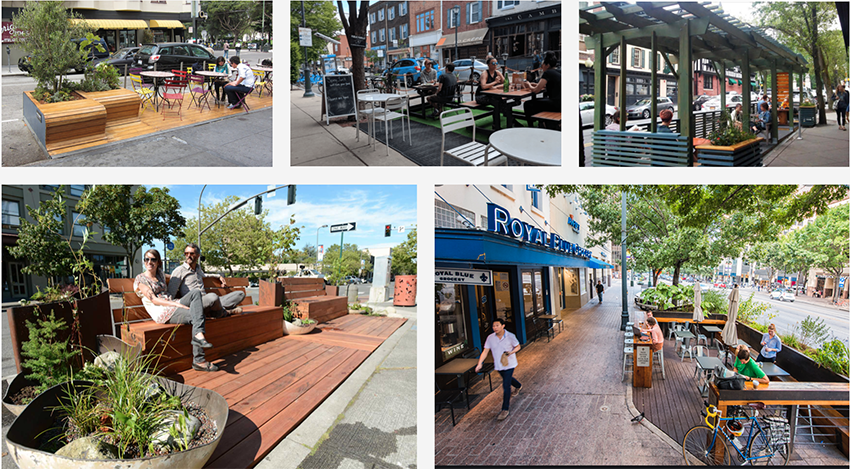
Parklets are often temporary and can be built quickly and relatively inexpensively. They are most often built on a platform so that they are level with the sidewalk. But there are plenty of examples where some planters and barricades delineate the space at street level. Installing these now wouldn’t preclude more permanent infrastructure changes in the future.
There are places along Duval where there is currently parking (300, 800, 900 blocks) or where the sidewalk narrows for temporary parking (200, 500, 600, 700 blocks) where parklets could be installed. On Upper Duval, beyond Truman Avenue, there’s parking on both sides of the street that could be used. Parklets shouldn’t just be for Duval Street. Anywhere downtown where there is retail should be able to participate. Think the 400 and 500 blocks of Southard and Fleming. The 400 block of Eaton. Why not White Street. Where else?
The City’s Multi-Modal Transportation Coordinator drafted a Parklets Ordinance almost a year ago. It seems to have gotten lost in the black hole of bureaucracy or what’s called departmental and City Attorney review. City staff don’t do Mayor Johnston any favors by burying good ideas. Time to dig this out and pair it up with the forthcoming Café Seating Permit revisions.
Additional information on Parklets:
- How We Get Wider Sidewalks Downtown Without Ripping Up the Streets – Parklets; February 26, 2021
- 20 Parklets on Duval in 2020; April 28, 2020
#2: Install Bike Corral Parking on Duval’s Cross Streets
We reported a few weeks ago that local bicycle shop owners have seen an uptick in rentals and sales this year. That’s a good thing. Getting people quickly and conveniently downtown by bike is an easy way to help pedestrianize the area. Walk around downtown and one sees full bike racks and people chaining their rides to every tree, pole, and fence in sight. That’s not so good as it clogs the sidewalks. So, let’s quickly add hundreds of bicycle parking spaces downtown. But stop erecting the one-off bike racks in the sidewalk that force people to walk single file on some blocks and instead install bike corral parking in the street. Corrals are a great solution for places where demand for bicycle parking exceeds the available sidewalk space. Where possible, install these adjacent to parklets to add protection and bring the consumer right to the product.
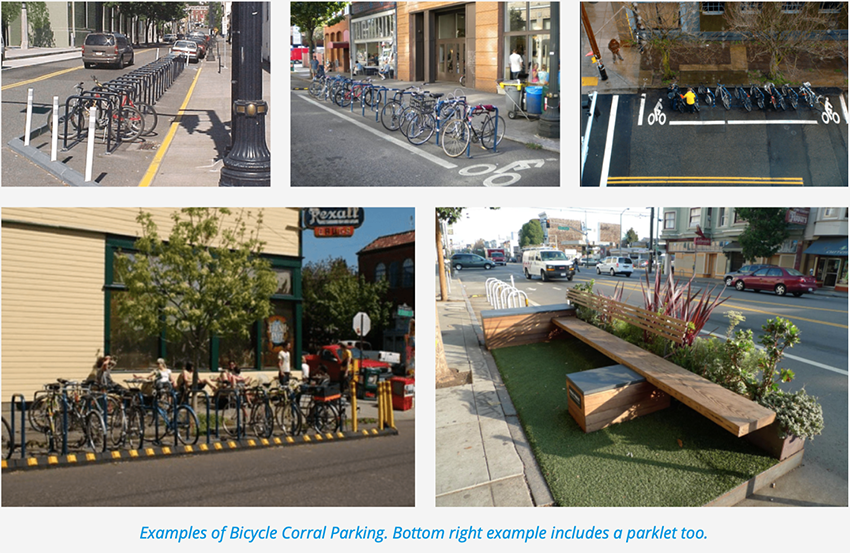
A few years ago, the Parking Director John Wilkins told me he thought that bicycle parking should be found in large numbers, corral style, on both sides of all the streets that cross Duval from Front to South Streets. This lends itself to installing scooter parking right next to the bicycles. Simply replace the first car parking space on each of these blocks with a bicycle corral and scooter parking. The space required for one car can accommodate from 10 to 20 bicycles so the trade off should be easy. And the regularity of having this on every block makes it easy to remember where bicycle parking is. It also is better for sight lines of turning vehicles and thus minimizes crashes with pedestrians and bicycles. You can see evidence of this concept on the 500 block of Eaton Street at Duval next to St. Paul’s. Also, on Petronia at Duval across from 801 Bar and Applerouth across from Mary Ellen’s. Mr. Wilkins has a great idea.
The City has hundreds of corral style racks in storage and plenty of money in the current and next year’s budget for more. But installation lags. Perhaps because the responsibility for bicycle racks sits with no one person or department. Community Services must find the time to install them, and the very busy Multi-Modal Transportation Coordinator Tim Staub must find the time to plan for and then request installation. This must then be approved by his superiors in Engineering before moving on to Community Services. More bureaucracy. And now Mr. Staub is leaving the City July 30 to go to grad school. The City is going to miss Tim’s good work!
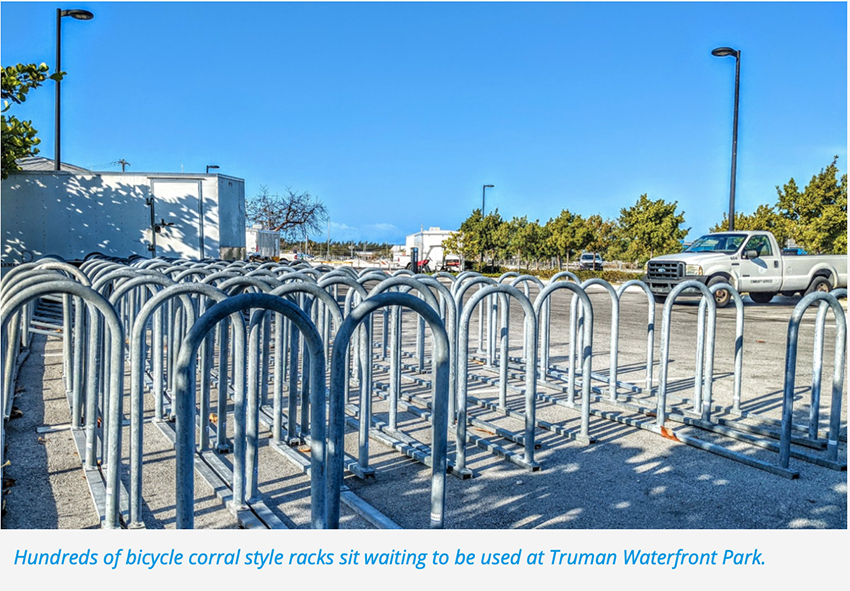
Perhaps we should designate Bicycle Parking the responsibility of Parking Director John Wilkins. His department is very on the ball, and he seems to understand the necessity for convenient bike parking. And if one is the director of car parking, why not bicycle and scooter parking too?
Additional Information on Bike Corral Parking:
- Bike Corrals – Local Business Impacts, Benefits, and Attitudes; Portland State University
- City of Portland Bicycle Parking Corrals Program
#3: Get Rid of Parking and Let the People Take the Street
We’ve been talking about pedestrianizing Duval for decades. If we want sidewalk cafés, parklets, bike parking and other amenities, we need to have the guts to take some space from cars. This doesn’t have to be an all or nothing proposition. We don’t need to block off all of Duval, perhaps a few blocks at a time. We don’t need to do it 24 hours, perhaps just at night. Maybe seven days a week. Maybe just the weekend. Maybe all year, maybe just during the season. Perhaps on some block’s cars are banned at certain times and maybe on other blocks we don’t even ban cars but just slow them down and make it so difficult that only people that really must drive on the block do so.
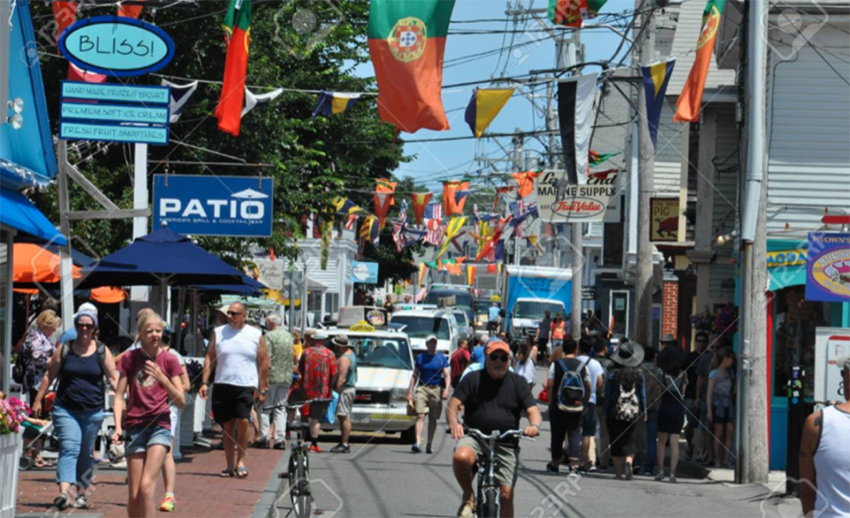
As a short-term temporary strategy, perhaps leading up to more permanent infrastructure solutions, in thinking about closing off a block to cars we should think about things like these:
- What about access for delivery vehicles?
- What about seniors, people with mobility or ADA issues that need to be dropped off at the front door?
- What about taxis, Ubers and Lyfts?
- What about hotels and inns with car access off Duval?
This doesn’t have to wait a few years for the results of a Duval Street Revitalization Plan. Let’s get back to experimenting and doing pilot projects like Mall on Duval. Retailers, restauranteurs, business groups, City staff and community members can surely come up with something. Perhaps the City’s Traffic and Pedestrian Friendliness element of the Key West Forward Strategic Plan could address and codify this.
If we can address these issues AND accommodate allowing people to take the streets, vendors to hawk their wares, artists to meet people and restaurants to provide places to sit then we’ll be getting somewhere.
Additional Information on Pedestrianizing Duval:
- Duval Street – We See the Future and it Could Start Now; June 24, 2020
- Eight Things We Can Do to Pedestrianize Duval and Still Allow Cars; March 6, 2021
- Want Sidewalk Cafés and Other Amenities? We Need to Take Some Space from Cars; May 28, 2021
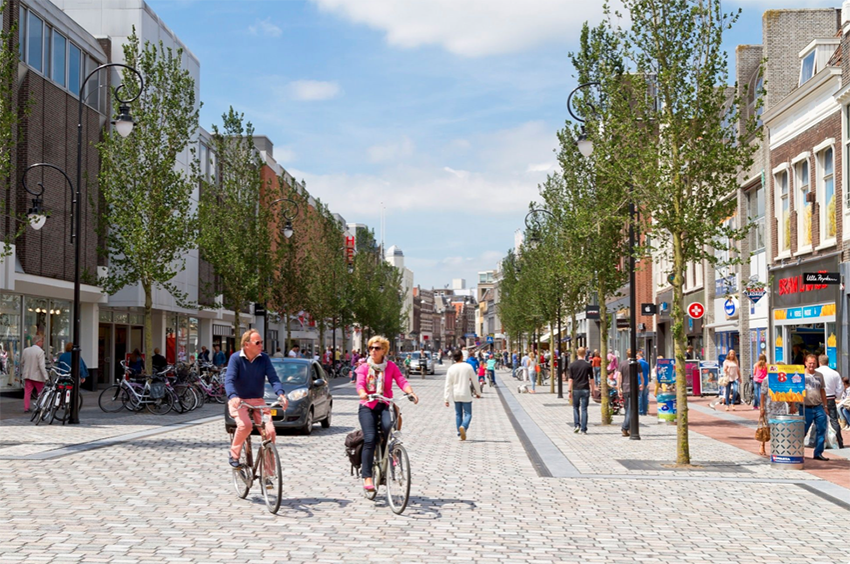
A Car-Centric Duval and Historic Downtown is So Mainland Florida
Key West is unique. Always has been. But shoehorning mainland-like car convenience on our mile-long Main and adjoining streets in our little historic downtown works against all the charm and eccentricity we bring to the table. Old Town is laid out more like an old European city. And yet we impose late 20th-century Orlando, Tampa and Miami-like car convenience right to our core. We need to double down on our historic, small block, grid pattern and make it more pedestrian and bike friendly. THAT’S more authentically Key West! That means less on-street car parking and less car access on those blocks. While the Duval Street Revitalization Plan will no doubt help with that, sadly it is years away from implementation. This summer and fall let’s at least do these three things to help us reclaim a little bit of downtown for people.
# # #
You can find all the KONK Life Streets for People column articles here and recent stories below:
- Limiting Large Cruise Ships Gives Us an Opportunity to Make Duval Street and Historic Downtown More Locals Focused, Again; July 9, 2021
- Mayor Bravely Puts Onus on Commission to Do Heavy Lifting on Bike, Walk and Transit. Will They Come Through?; July 2, 2021
- Monorail, Monorail, Monorail or Just Say No to Privatizing Key West Parking; June 25, 2021
- New City Manager Will Be Good for Bike, Walk, Transit and for Key West; June 18, 2021
- PeopleForBikes Ranks Key West 39th Best City for Bicycling; June 11, 2021
- First and Bertha Streets Corridor Road Improvements Are Another Missed Opportunity to Make Bicycling Safer and Easier; June 4, 2021
- Want Sidewalk Cafe’s and Other Amenities? We Need to Take Some Space from Cars; May 28, 2021
- In Quest to Improve Crosstown Greenway, City Prepares to Construct New Bike Trail Segment; May 21, 2021
- How Better Transit and Bicycle Facilities Can Help Address Affordable Housing; May 14, 2021
- City Commission Tries to Have Its Cake and Eat It Too on S. Roosevelt Blvd. – Perhaps Dooming a Safer Project; May 7, 2021
- What’s Old is New Again – Two New Bike Trails Take Us Back in Time to a Simpler Key West, April 30, 2021
- Do Key West Commercial Areas Need Business Improvement Districts (BIDS)? – Part 2: What BIDS in Key West Might Look Like, April 23, 2021
- Do Key West Commercial Areas Need Business Improvement Districts (BIDS)? – Part 1: What’s a BID?; April 16, 2021
- The Good, the Bad and the Ugly – A Dozen Marketing Things KW Transit Can Do to Increase Ridership; April 9, 2021
- The Sorry State of Key West Bus Stops – We Just Don’t Care; April 2, 2021
- It’s Time to Reconsider a Road Diet on S. Roosevelt and Make the Promenade and Road Safer; March 26, 2021
- Getting the Parking Right Leads to Streets for People – Part 2: Battling Our Inner George Costanza – Ten Things We Can Do in Downtown Key West to Get the Parking Right; March 19, 2021
- Getting the Parking Right Leads to Streets for People – Part 1: Nobody Goes there Anymore. It’s Too Crowded – Six Reasons for Right Pricing Parking; March 12, 2021
- Eight Things We Can Do to Pedestrianize Duval and Still Allow Cars, March 5, 2021
- How We Get Wider Sidewalks Downtown Without Ripping Up the Streets – Parklets; February 26, 2021
- The Wee Donkey, Whataboutism, Bathwater and Duval Street’s Future; February 19, 2021
- Averting E-Bike Mayhem and Making Key West Sidewalks Safer; February 12, 2021
- Sustainability Board Wants to Make Free, Frequent and Simple Key West Transit a Reality, February 5, 2021
- Volunteers and a Little Green Paint Show How We Can Make it Safer to Bike;January 29, 2021
Chris Hamilton is founder of the local advocacy group Friends of Car-Free Key West & Duval Street/Historic Downtown. He’s a native of the District of Columbia, where for a couple decades+ he led nationally renowned efforts promoting transit, bike, walk and smart growth for Arlington County, VA’s DOT. Chris has lived in Key West since 2015. He lives downtown and works and volunteers for a couple non-profits.
[livemarket market_name="KONK Life LiveMarket" limit=3 category=“” show_signup=0 show_more=0]

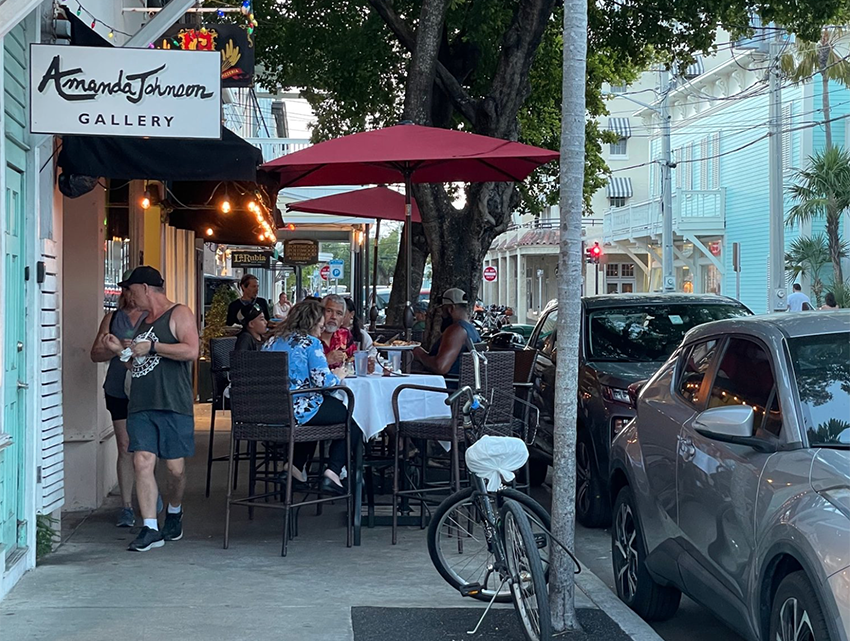

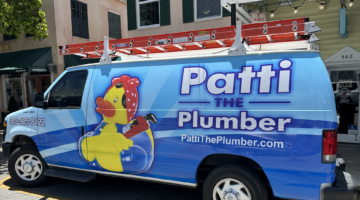

No Comment